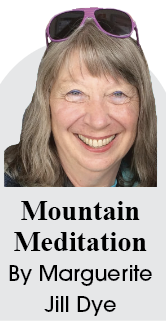Author’s note: This is part two of a series on the Dye family Vermont adventure. 
We always arrived in Killington late on our drive from New Jersey on the highways. After winding our way up dark mountain roads, we forded across Roaring Brook (before the bridge was built), rounded the bend, and climbed to the start of our steepest incline. Dad took a deep breath, floored the gas, and got a running start up our driveway. The engine roared as we took off 1 mph straight uphill. Our loaded-down station wagon was so low, especially with massive beams on top, the bottom scraped and dragged on rocks as it bounced up our driveway (steeper than the Cat Walk—the steepest ski trail I skied on).
Unloading the car in the dark was a challenge in itself—food, water, tools and building supplies, sleeping bags, pillows, furniture and clothes. By then we were bushed and ready for bed.
At first, we cleared space in the woods for the tent that we slept in for the first year in Vermont. I slept on the ground and felt the tree roots under my sleeping bag and pillow. I wiggled until they were in the right spots. I was a kid. I could sleep anywhere and was excited we were all together, under tall trees, dancing leaves, and twinkling stars, as long as it didn’t rain…
Storing necessities outside overnight was a challenge we didn’t anticipate. Raccoons outsmarted us week after week, prying open our outdoor cupboard expertly. We closed the doors tightly with twisted wire to no avail—they still entered. When my brother Jack arrived from UNH, he came up with the solution—a key and lock raccoons couldn’t open.
Dad looked forward to the man’s arrival with the divining rod in hand. He invited me along and explained the natural science of the downturning branch that sought water when the source was near. I watched the Vermonter hold the Y-shaped branch which soon pointed downward. It moved slowly like a ouiji board arrow. We blasted with dynamite and dug way down to establish a well where the divining rod man said.
Dynamite carved out a tiny pond where tadpoles grew into happy frogs. But it didn’t yield the water we needed, so we dug in a second spot—deeper and deeper. Dad grumbled about the cost of digging 350 feet down. (Later, we discovered our best source of water turned out to be a spring under our house.)
Our black lab, Star, loved getting wet so we enjoyed our minuscule pond. When I waded in, she swam in too, crossing it with a couple of paddles. She loved to chase frogs that leapt off the edge and over her head.
A devoted Lab, Star wanted to help. Whenever we cut down a sapling or branch and heave-ho’d it over the ridge, Star ran down to grasp it in her mouth, then she dragged it back up to us.
New experiences awaited us each weekend—from cutting down trees, bushes and shrubs to clearing the land to build our ski lodge. It was Dad‘s life-long dream—which turned out to be a surprise for Mom. (I guess they’d never discussed it before Dad announced he’d bought Vermont land.) It was my father’s idea of Heaven, but, for Mom, a nightmare in Hell—hauling spring water from Route 100, sleeping in the woods on a cot in our tent, being cold all day and freezing all night, cooking outdoors on a Coleman camp stove, and competing with critters for our food…
It was not how our rather erudite mother (a descendant of the Kings of France) expected to be living her life. I heard my aunt (from an Illinois farm) say, “Marguerite always needed the best seat in the buggy.”
But Mom rose to the occasion, rolled up her sleeves, and pitched in to do what was needed for the pioneer spirit was also in her genes. Mom’s grandfather was raised on a plantation, left South Carolina after the Civil War, mined for gold and later became head of the gold mine in the Black Hills. Mom’s mother was raised in Spearfish Canyon, South Dakota with five siblings. As pioneers, they eked out an existence, poor in materials but rich in experiences. Family history repeats itself. Like Mom’s grandparents, Mom and Dad were staking their claim, but in Vermont on our land.
For several years, we had an outhouse, a one-seater up the path in the woods. Mom decorated it with travel posters when she began work as a travel agent. A Sears Roebuck Catalog was added for effect, and for sissies like me, a roll of toilet paper. Dad cut a half moon in the door, but in good weather, I kept it open. The view from our outhouse couldn’t be beat of Pico and Killington silhouetted against sky. Lanterns and flashlights lit our way along the trail in the dark. I was the only kid I knew who had an outhouse still in use.
Later, Dad built a fun two-seater, located outdoors between two tree trunks. We had a pail of lime powder to sprinkle on top of the holes in the ground. Mom and I were sitting upon it the day it broke and we fell in. Dad and my male friend from home yelled, “Can we help pull you out?” Mom and I were laughing so hard we could barely holler “NO!” During the night and in cold weather, we switched to an old fashioned “honey pot” which I preferred when I heard the sounds of critters howling and stomping through the woods. To be continued…
Marguerite Jill Dye is an artist and writer who lives in Killington and Florida.

By Marguerite Jill Dye
Cut paper artwork of the half moon on the author’s outhouse door in the forest.




